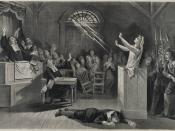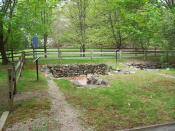The Crucible by Arthur Miller as well as the maps, text and charts of Enduring
Visions clearly show a growing resentment between the 'have nots' of Salem Village
and the 'haves' of its more easterly neighbor Salem Town. Salem was presided over by
the Rev. Parris. By 1692, Salem had become a divided and disturbed community.
Hidden behind the sacred crusade of Rev. Parris and the petty jealousies and hates of the
Putnams and Abigail Williams is a community that is far removed from the original
intention of Gov. Winthrop and the ideals of 'The New England Way'. Miller points out
that as the Puritan community became more divided against itself so grew its need to set
off a wave of hysteria in the presence of Satan.
The map on p. 49 clearly marks a battle line being drawn between the less
successful hard dirt farmers of the Village accusing many of their Puritan Church
members of the more prosperous harbor (who were mostly merchants) of witchcraft.
The
New England Way as conceived by John Winthrop was slowly disintegrating by the
beginning of the Salem Witch Trials of early 1692. The Factionalism And Wealth Chart
in Enduring Visions , demonstrates very clearly that those whose family income was less
than 10 shillings ( 61%) were for the Rev. Parris and his entreaties of witchcraft. The
more prosperous families, those whose family income exceeded 20 shillings ( 23%) were
opposed to witchcraft accusations. The Rev. Samuel Parris is a frightened extremely
weakened man who has little or no faith. He is a self-serving man more worried about
his position than his supposedly ailing daughter. He spends all of his time protecting
himself and his position of authority rather than comforting his flock that is being
menaced by Satan. The...


